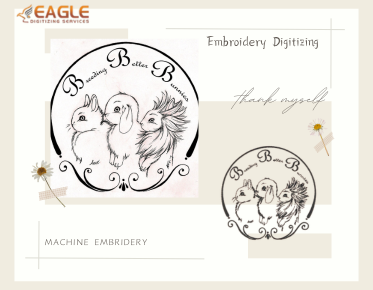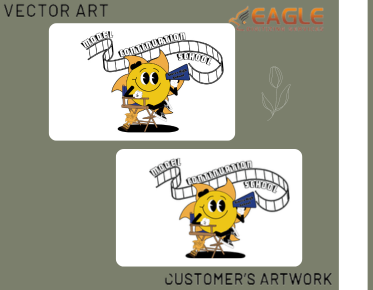Crafting Smarter: How AI Can Affect Digitizing Embroidery
The integration
of artificial intelligence into the world of embroidery is revolutionizing the
way designs are digitized and produced. In this article, we’ll explore how AI
technology can streamline the digitizing process, enhancing both efficiency and
creativity. From automating complex patterns to improving stitch accuracy, AI
tools are transforming traditional embroidery techniques into smarter, more
innovative practices. Join us as we delve into the impact of AI on the
embroidery industry and discover how it can elevate your crafting experience.
The Role of AI in Modern Crafting: A Game Changer
Artificial
Intelligence (AI) is revolutionizing the crafting landscape, particularly in embroidery.
By integrating AI into the digitizing process, creators can leverage
intelligent algorithms to streamline workflows and enhance creative
possibilities. This technology acts as a catalyst for innovation, allowing for
quicker turnarounds and higher-quality outputs. With AI, traditional crafting
techniques are enriched, paving the way for a new era of embroidery where
precision and creativity coexist harmoniously.
Understanding AI Technology
Breaking
Down Artificial Intelligence: What You Need to Know
The goal of the
computer science discipline of artificial intelligence is to build machines
that can carry out tasks that normally call for human intelligence. This
includes a variety of technologies, such as computer vision, natural language
processing, and machine learning. AI systems analyze data, learn from patterns,
and make decisions, all of which are fundamental to enhancing the crafting
experience. By understanding these core principles, creators can appreciate how
AI can serve as a powerful tool in their embroidery endeavors.
How
AI Works in Creative Fields: A Quick Insight
In creative
fields, AI functions as an assistant, augmenting human creativity rather than
replacing it. By analyzing vast amounts of data, AI can identify trends,
suggest design elements, and even generate unique patterns based on user input.
This collaboration between humans and machines fosters an environment where
artistic expression flourishes, enabling designers to explore new avenues while
saving time on repetitive tasks. The synergy between AI and creativity leads to
innovative outcomes, pushing the boundaries of what’s possible in embroidery.
The
Evolution of AI: From Concept to Application
The evolution of
AI has been remarkable, transitioning from theoretical concepts to practical
applications. Early AI systems were rudimentary, and primarily focused on basic
problem-solving. Over the years, advancements in computing power and data
availability have propelled AI into sophisticated realms, enabling it to tackle
complex tasks with ease. Today, AI is an integral component of numerous
industries, including embroidery, where it simplifies processes and enhances
creativity. This journey showcases the transformative potential of AI and its
ability to reshape traditional crafts.
AI in the Digitizing Process
Streamlining
the Workflow: How AI Simplifies Digitization
AI streamlines
the digitizing workflow by automating various aspects of the design process.
Traditional digitization requires extensive manual input, from tracing designs
to adjusting stitch parameters. AI-powered software reduces these burdens by
offering automated features that analyze images and generate stitch files with
minimal human intervention. This efficiency not only accelerates the
digitization process but also minimizes errors, ensuring that designs are
accurately represented in the final product.
Automated
Design Generation: Creating Embroidery Designs with AI
Automated design
generation is one of the most exciting applications of AI in embroidery. By
inputting basic parameters, users can generate unique designs that might take
hours to create manually. This capability allows for a vast array of options,
catering to different styles and preferences. The software can even suggest
modifications, enabling users to experiment with colors, stitch types, and
layouts. This level of automation unleashes creative potential, making it
easier for both beginners and seasoned embroiderers to explore innovative
designs.
Enhancing
Precision: The Role of AI in Stitch Placement
Precision is
paramount in embroidery, and AI excels in ensuring accurate stitch placement.
By utilizing advanced algorithms, AI can analyze the design's intricacies and
calculate the optimal placement of stitches. This minimizes the risk of
misalignment and enhances the overall quality of the final product. The result
is a professional finish that reflects the artist's vision, all while reducing
the time spent on manual adjustments. With AI handling the details, creators
can focus on what truly matters: their creativity.
Benefits of AI in Digitizing Embroidery
Time-Saving
Advantages: Faster Design Turnaround
One of the most
significant benefits of AI in digitizing embroidery is the substantial
time-saving it offers. With automation streamlining the digitization process,
designers can produce high-quality designs in a fraction of the time it would
typically take. This rapid turnaround not only enhances productivity but also
allows for quicker fulfillment of client orders. In a world where speed is
often equated with success, leveraging AI can provide a competitive edge.
Consistency
in Quality: Ensuring Uniform Results
AI contributes to
consistency in quality, which is essential for any successful embroidery
business. By minimizing human error and ensuring that designs are executed
precisely, AI helps maintain uniformity across batches of products. This
reliability fosters trust among customers, who can expect the same high quality
every time they order. Consistent results are particularly crucial for
businesses that rely on bulk orders, making AI an invaluable asset in the
embroidery industry.
Expanding
Creative Possibilities: New Design Horizons
The integration
of AI in embroidery opens up a realm of creative possibilities previously
unimagined. With AI-generated designs, artists can explore styles that blend
traditional techniques with modern aesthetics. The technology encourages
experimentation, allowing users to push boundaries and discover new techniques.
This fusion of art and technology nurtures an environment of innovation, where
creativity knows no limits.
Challenges of Implementing AI in Embroidery
Understanding
Limitations: What AI Can and Cannot Do
While AI brings
numerous advantages, it is crucial to understand its limitations. AI excels in
data-driven tasks but lacks the innate human intuition that often guides
artistic endeavors. There are nuances in creativity that AI cannot replicate,
such as emotional resonance or cultural context. Recognizing these boundaries
allows artists to use AI as a tool rather than a replacement, ensuring that the
human touch remains integral to the crafting process.
The
Learning Curve: Adapting to New Technologies
Adapting to new
technologies can present challenges, especially for those accustomed to
traditional methods. Learning to navigate AI-powered software requires time and
patience, as users must familiarize themselves with new workflows and tools.
This learning curve can be daunting, but embracing it opens up opportunities
for growth and development. Workshops, tutorials, and community forums can
facilitate this transition, helping crafters maximize the potential of AI in
their work.
Balancing
Automation with Artistic Touch: Finding the Right Blend
Finding the right
balance between automation and artistic expression is vital in the world of
AI-enhanced embroidery. While automation offers efficiency, over-reliance on
AI-generated designs may lead to a loss of personal touch. Striking a
harmonious blend between human creativity and technological assistance is key.
By integrating AI as a collaborative partner rather than a substitute, artists
can create unique, meaningful works that resonate with their audience.
Real-World Applications of AI in Embroidery
AI-Powered
Software: Tools Revolutionizing the Industry
AI-powered
software is at the forefront of revolutionizing the embroidery industry. Tools
such as embroidery digitizing programs and design generators enable users to
create intricate patterns effortlessly. These applications harness the power of
AI algorithms to analyze designs and produce high-quality outputs that meet
professional standards. By incorporating AI into their workflows, embroidery
businesses can enhance efficiency, reduce costs, and stay competitive in a
rapidly evolving market.
Successful
Integration of AI in Embroidery Businesses
Several
embroidery businesses have successfully integrated AI into their operations,
demonstrating its transformative impact. For instance, companies specializing
in custom apparel have adopted AI design tools to meet the increasing demand
for personalized products. By automating the design process, these businesses
can offer quick turnaround times while maintaining high quality. Case studies
illustrate how AI can drive growth and innovation, inspiring others in the
industry to follow suit.
Customization
at Scale: How AI Meets Unique Client Needs
AI enables
customization at scale, allowing embroidery businesses to cater to unique
client needs without sacrificing efficiency. By leveraging AI-driven design
tools, companies can quickly produce personalized items for large orders, from
corporate branding to event merchandise. This capability enhances customer
satisfaction, as clients receive tailored products that reflect their
individual styles. The scalability provided by AI empowers businesses to thrive
in a competitive landscape.
The Future of AI in Embroidery
Trends
to Watch: What’s Next for AI Technology in Crafting
The future of AI
in embroidery is ripe with potential, and several trends are poised to shape
the industry. Expect to see advancements in machine learning algorithms that
enhance design generation and customization. Additionally, AI's integration
with augmented reality (AR) could allow users to visualize designs in real time
before committing to production. These trends will continue to evolve, pushing
the boundaries of creativity and technology in embroidery.
Predictions
for the Future: How AI Will Shape the Industry
Predictions
indicate that AI will become increasingly sophisticated in its role within the
embroidery industry. As technology advances, expect to see more intuitive
design tools that require minimal input from users. The ability to create
complex designs with ease will empower a new generation of crafters to explore
their creativity. Furthermore, AI may pave the way for more sustainable
practices in embroidery, utilizing algorithms to optimize resource use and
minimize waste.
Opportunities
for Innovation: Emerging Technologies in Embroidery
Emerging
technologies present abundant opportunities for innovation in embroidery. The
combination of AI with other advancements, such as 3D printing and blockchain
for traceability, could revolutionize the industry. By exploring these
intersections, embroidery businesses can create novel products and processes
that captivate consumers. Embracing innovation will be crucial for staying
relevant and meeting the ever-evolving demands of the market.
Ethical Considerations in AI Use
The
Debate Over Creativity: Can AI Truly Be Artistic?
The question of
whether AI can be truly artistic is a complex and nuanced debate. While AI can
generate impressive designs, it lacks the emotional depth and personal
experiences that inform human creativity. This distinction raises questions
about authenticity and the essence of art itself. As the lines blur between
human and machine-generated creations, society must grapple with the
implications of AI in the creative process.
Copyright
and Originality: Navigating Legal Issues in AI-Generated Designs
The rise of
AI-generated designs brings forth legal challenges related to copyright and
originality. As AI systems produce unique patterns, determining ownership and
rights becomes increasingly complicated. Navigating these legal waters requires
a clear understanding of intellectual property laws and how they apply to
AI-generated works. Establishing guidelines and frameworks will be essential in
protecting the interests of creators while encouraging innovation.
The
Impact on Traditional Craftsmanship: Balancing Innovation with Heritage
As AI technology
permeates the embroidery landscape, the impact on traditional craftsmanship is
inevitable. While innovation enhances efficiency and creativity, it risks
overshadowing the skills and techniques that define handcrafted art. Striking a
balance between embracing technology and honoring traditional practices is
crucial for preserving the rich heritage of embroidery. This delicate
equilibrium allows the craft to evolve while respecting its roots.
The intersection of AI and embroidery heralds a new era of creativity and innovation. By leveraging AI technology, designers can enhance their workflows, expand their creative horizons, and deliver unique products to clients. Embracing AI tools in the crafting process not only streamlines operations but also empowers artists to push boundaries and explore new possibilities.
.png)


